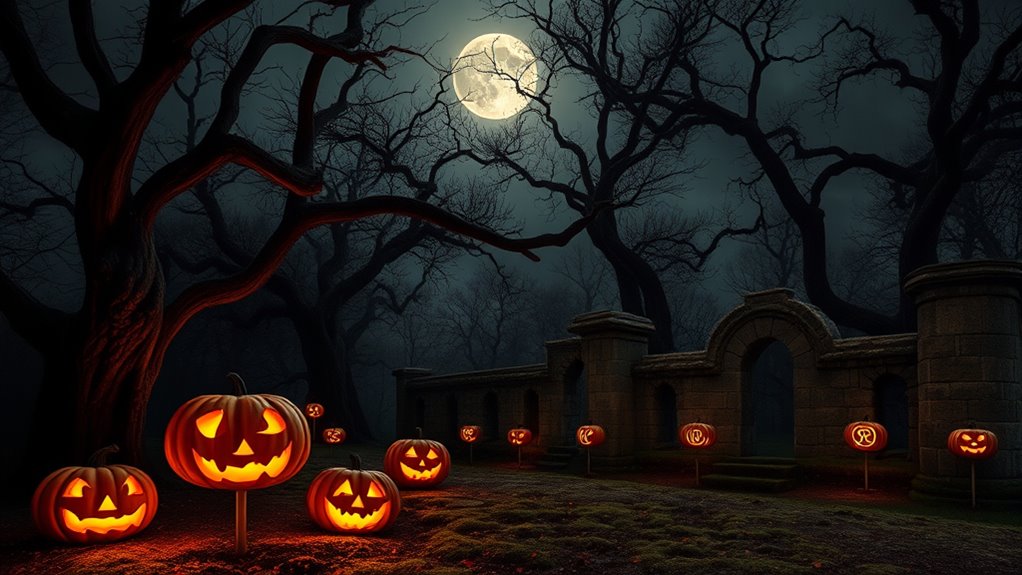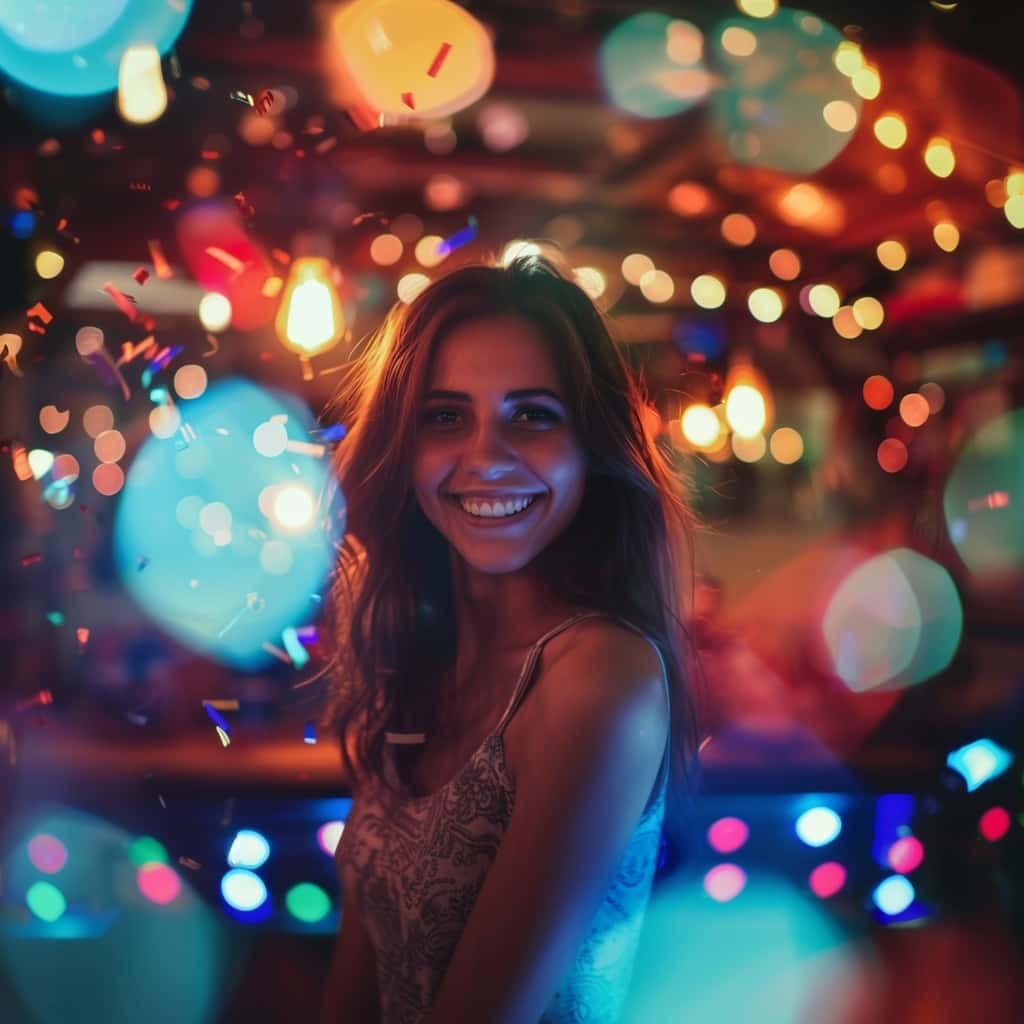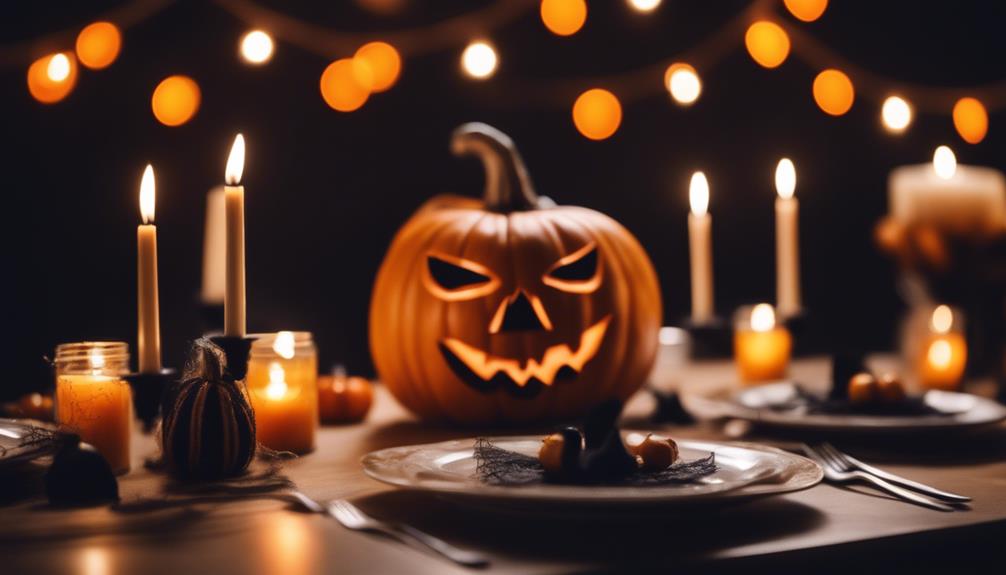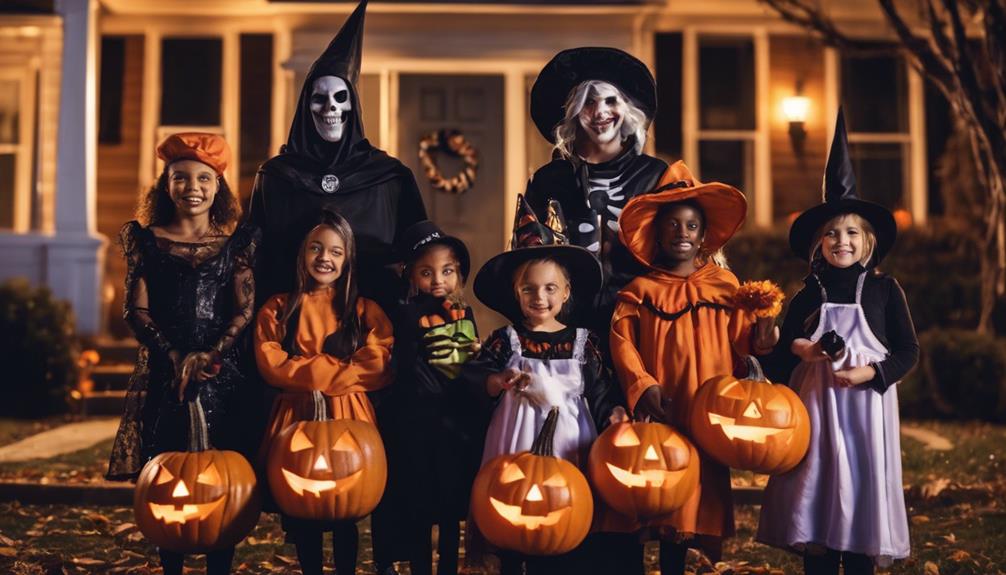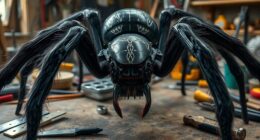Halloween started centuries ago with the Celtic festival of Samhain, marking the end of harvest and a time when spirits could cross into the living world. Over time, Roman and Christian influences blended into new customs like costumes, bonfires, and honoring ancestors. Today, Halloween is a fun, community-filled celebration featuring costumes, trick-or-treating, and spooky decorations. To discover how these ancient traditions shaped modern festivities, explore more about its fascinating evolution.
Key Takeaways
- Halloween originated from the Celtic festival of Samhain, marking the end of harvest and the start of winter.
- Samhain involved honoring spirits, with customs like bonfires and disguises to ward off or communicate with the dead.
- Roman festivals such as Feralia blended with Celtic traditions, influencing Halloween’s customs and symbols.
- Christian church efforts led to All Hallows’ Day, evolving into All Hallows’ Eve and later Halloween.
- Modern Halloween combines ancient rituals, cultural influences, and new traditions like trick-or-treating and costume celebrations.
The Ancient Celtic Festival of Samhain
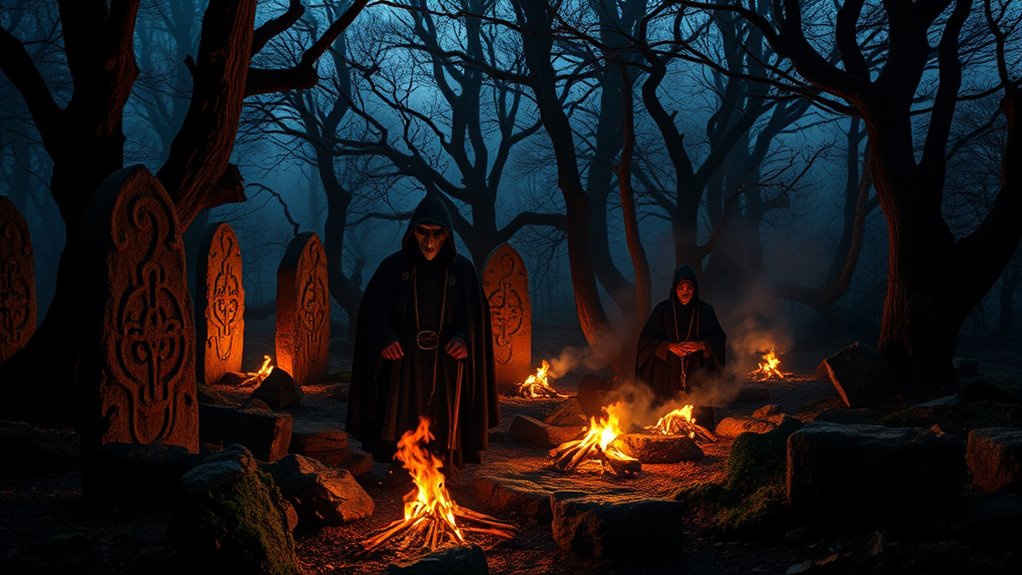
Have you ever wondered where Halloween’s roots lie? It all traces back to the ancient Celtic festival of Samhain, a crucial part of Celtic mythology. This festival marked the end of the harvest season and the start of winter, symbolizing a major seasonal shift. During Samhain, the Celts believed the boundary between the living and the dead blurred, allowing spirits to cross into the human world. To honor these spirits and ward off unwanted guests, they lit bonfires and wore costumes. These traditions reflected their deep connection to nature’s cycles and the changing seasons. Samhain wasn’t just about celebrating the harvest; it was a time when the Celts acknowledged the spiritual domain’s influence on their lives, shaping many customs that persist today. Samhain’s significance highlights how ancient beliefs continue to influence modern Halloween traditions.
Rituals and Beliefs of the Celts

You notice that the Celts placed great importance on honoring their ancestors through special rites. They believed spirits could cross into the living world during Samhain, so they practiced communication with these spirits. These rituals helped them connect with the past and seek guidance from those who came before.
Ancestor Honoring Rites
Among the rituals practiced by the ancient Celts, honoring ancestors held a central place in their spiritual life. You would see them making ritual offerings to ancestral spirits, believing these spirits influenced their daily lives and future. They left food, drink, and symbolic items at sacred sites or family altars, inviting their ancestors to partake and stay connected. These offerings reinforced bonds between the living and the dead, ensuring protection and guidance. The Celts believed that honoring ancestors kept their spirits close, especially during significant times like Samhain. By respecting and remembering their forebears through ritual offerings, they maintained spiritual harmony and lineage continuity, which ultimately shaped their understanding of mortality and the cycles of life and death. Additionally, they believed that these water-based offerings had the power to purify and strengthen the spiritual connection between worlds.
Spirit Communication Practices
Honoring ancestors often involved rituals that aimed to communicate with spirits, reflecting the Celts’ belief that the boundary between the living and the dead was permeable. They used tools like Ouija boards and spirit photography to facilitate this connection. Ouija boards, though more modern, mimic ancient divination methods, allowing you to ask questions and receive messages from spirits. Spirit photography, which emerged in the 19th century, captured images believed to show spirits or ghostly apparitions, reinforcing the idea that the dead could be seen and communicated with beyond death. These practices exemplify the Celtic desire to maintain a connection with loved ones and spirits, especially during times like Samhain, when the veil between worlds was thinnest. Additionally, these rituals often involved specific spiritual communication practices that helped deepen the connection between the living and the spiritual realm.
Roman Influence and Christian Adaptation

Roman festivals like Feralia and Lemuria blended with local traditions, shaping how Halloween evolved. The Christian church responded by establishing All Saints Day, also called All Hallows, to replace pagan practices. This merging of cultures created a lasting tradition of cultural syncretism that influences Halloween today. Developing Cultural Intelligence allows communities to understand and respect these diverse cultural origins, ensuring the preservation and appreciation of such rich traditions.
Roman Festivals Merging
As Christianity spread throughout the Roman Empire, it began to absorb and transform existing pagan festivals. Roman harvest festivals, which celebrated the bounty of the land, often included lively medieval masquerades and public revelries. As these festivals merged with Christian practices, church leaders sought to redirect popular pagan customs into more spiritual observances. Over time, pagan elements like costumes and public gatherings persisted, blending seamlessly into Christian festivals. These merged celebrations helped ease the shift from ancient pagan rites to Christian traditions, making the new faith more acceptable. The influence of Roman festivals created a foundation for future festivities, where communal joy and symbolic costumes played a central role, eventually evolving into the Halloween traditions we recognize today. Additionally, the incorporation of public gatherings fostered a sense of community that remains a hallmark of modern holiday celebrations.
Christian All Saints Day
| Christian All Saints Day | Roman Influence and Christian Adaptation |
|---|---|
| Christian All Saints Day, also known as All Hallows’ Day, emerged as a way for the church to Christianize and replace older pagan festivals that celebrated the dead and saints. | The church designated November 1st for this Religious Commemoration, aligning it with existing autumn festivals. |
| It aimed to honor saints and martyrs, shifting focus from pagan spirits to Christian figures. | This adaptation helped ease pagan populations into Christian practices, blending old customs with new religious observances. |
| Over time, it became a key annual event, influencing how communities remembered the dead and celebrated saintly virtues. | The holiday’s evolution reflects the Roman influence on Christian traditions, shaping the way we observe All Saints Day today. |
| Additionally, the integration of cultural celebrations into Christian observances facilitated the widespread acceptance of the holiday across diverse communities.
Cultural Syncretism Evolution
The evolution of Halloween reflects a rich process of cultural syncretism, where ancient Roman traditions blended seamlessly with Christian practices to create a unique holiday. Roman festivals like Feralia, honoring the dead, incorporated medieval folklore themes of spirits and the afterlife. As Christianity spread, these customs adapted into Christian observances such as All Hallows’ Eve, emphasizing saints and spiritual reflection. Over time, this fusion influenced contemporary symbolism, like jack-o’-lanterns representing spirits and costumes portraying supernatural beings. You’ll find that modern Halloween combines these historical elements, transforming pagan and Roman rituals into a secular celebration. This blending of influences highlights how cultural exchange and religious adaptation shaped the holiday into the multifaceted event you observe today. Additionally, the ongoing process of creative practice demonstrates how traditions evolve through continuous cultural engagement and reinterpretation.
The Evolution of Halloween Traditions

Over centuries, Halloween traditions have transformed from ancient rituals into modern celebrations filled with costumes, trick-or-treating, and spooky decorations. One of the most iconic customs is pumpkin carving, which evolved from the Irish practice of creating lanterns called Jack-o’-lanterns. Today, you see elaborately carved pumpkins lighting up doorsteps and windows. Costume trends have also shifted over time, from simple disguises to creative, themed outfits that reflect pop culture, horror characters, or personal interests. You now have endless options, from spooky to humorous, and even elaborate cosplay. These traditions have become central to Halloween’s festive spirit, allowing you to express yourself and connect with others through shared customs. The evolution of these practices continues to shape how you celebrate Halloween each year. Additionally, understanding the safety and storage of Halloween decorations and costumes helps ensure a fun and secure holiday experience.
Modern Celebrations and Cultural Significance

Modern Halloween celebrations have become a vibrant mix of fun, community, and cultural expression. You’ll see people embracing costume customs that range from spooky to creative, showcasing personal style and imagination. Modern festivities often include street parties, haunted houses, and costume contests that bring neighbors together. Trick-or-treating remains a beloved tradition, where children and adults alike enjoy collecting candies and treats. These celebrations reflect both historical roots and contemporary trends, emphasizing entertainment and social bonding. You might also notice themed decorations and community events that highlight local culture. Additionally, the use of decorative items such as pumpkin carvings and themed ornaments has become a hallmark of festive atmospheres. Overall, modern festivities serve as a way for you to connect with others, express yourself, and enjoy a night filled with playful spookiness and festive cheer.
Halloween’s Global Influence and Variations

Halloween has spread beyond its origins in Ireland and the UK, inspiring diverse celebrations across the globe. Today, many countries have adopted unique customs that reflect local culture. For example, in the US, trick or treat origins trace back to medieval practices and later Victorian influences, evolving into children’s door-to-door candy collecting. Meanwhile, costume evolution has expanded from simple disguises to elaborate outfits, often inspired by popular movies or cultural symbols. In Mexico, Dia de los Muertos blends Halloween traditions with honoring deceased loved ones, creating a vibrant, meaningful event. In Japan, themed parties and cosplay highlight the global influence of Halloween, emphasizing creativity and fun. Overall, Halloween’s international variations demonstrate how it has become a versatile celebration, adapting to different cultural contexts worldwide. Additionally, regional divorce statistics can influence how communities celebrate or perceive these festivities.
Frequently Asked Questions
How Did Halloween Spread From Europe to North America?
Like a flickering candle crossing borders, Halloween spread from Europe to North America through cultural diffusion and migration patterns. As immigrants carried their traditions, they ignited new celebrations, blending old customs with local influences. Over time, these practices transformed, creating a uniquely North American Halloween that reflects a tapestry of cultural stories. Your ancestors’ journeys fueled this cultural exchange, turning a European harvest festival into a vibrant, nationwide celebration today.
What Are Some Lesser-Known Ancient Halloween Customs Worldwide?
You’ll find that around the world, ancient Halloween customs incorporate ancestral rituals and mystical symbols. In Mexico, the Day of the Dead honors ancestors with offerings and decorated altars. In Japan, Obon involves lantern festivals guiding spirits home. In Ethiopia, the Ganna festival celebrates saints with unique dances. These lesser-known customs reveal how different cultures connect with spirits, honoring ancestors through rituals filled with mystical symbols that bridge the living and the dead.
How Have Halloween Costumes Evolved Over Centuries?
Costume evolution on Halloween is like a tapestry woven over centuries, constantly changing. You see, masks once carved from wood or masks made from fabric have transformed into elaborate creations using modern materials like plastic and foam. Today, you can don anything from spooky monsters to pop culture icons, showing how costume materials and mask evolution reflect society’s creativity. Your Halloween dress-up now tells a story, blending history with innovation.
Are There Any Traditional Halloween Foods From Ancient Times?
You’ll find that traditional Halloween foods have roots in ancient recipes and delicacies. In ancient times, people often ate hearty foods like bread, apples, and nuts to celebrate the harvest season. Some cultures prepared special treats like soul cakes or roasted pumpkins. These traditional delicacies helped mark the shift from summer to winter, connecting modern Halloween celebrations to their historical origins and the importance of seasonal foods.
How Does Halloween Influence Modern Pop Culture and Media?
Halloween heavily influences modern pop culture and media portrayals, shaping your favorite movies, TV shows, and costumes. You see references to haunted houses, spooky characters, and horror themes that create a festive, eerie atmosphere. Pop culture references like iconic villains and supernatural stories keep Halloween relevant and exciting, making it a yearly event where media celebrates the spooky spirit, inspiring your costumes, parties, and media consumption.
Conclusion
Understanding Halloween’s journey from ancient Samhain to today’s festivities shows how traditions evolve yet remain connected to our roots. As you celebrate with costumes and candy, consider the centuries of history behind these customs. Isn’t it fascinating how a festival once meant to honor spirits now unites people worldwide in fun and community? Embrace the story behind the holiday, and keep the legacy alive in your own way.
